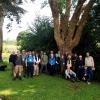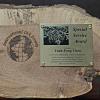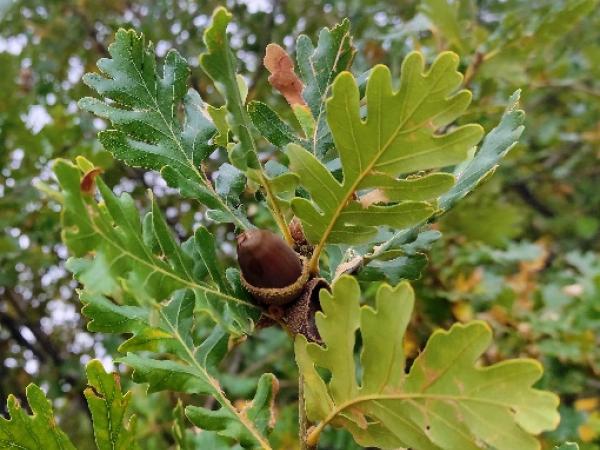Editor's Picks
Plant Focus
Eastwoodhill is the National Arboretum of New Zealand, located on the East Coast of the North Island 35 km northwest of Gisborne. It is considered to be the largest collection of Northern Hemisphere trees growing south of the Equator, and the over 3,600 taxa that can be found there include a large number of oak species. But before discussing the Quercus collection, it is worthwhile recounting the arboretum’s colorful history, which features the remarkable life story of its creator, Douglas Cook. Author John Berry titled his book on Eastwoodhill "A Man's Tall Dream," and indeed the arboretum owes its existence to the vision of this remarkable plantsman.
William Douglas Cook, “Cookie” to his friends, was described in a New Zealand Gardener magazine editorial as “a plantsman with the soul of a poet and the vision of a philosopher [who] has subordinated all his other interests to the creation of a garden that promises to become a national asset.”[i] Born in 1884, he initiated the creation of his life’s work in 1910, when he acquired a farm of 250 hectares in the Ngatapa settlement. He had left home at 17 and an initial venture with a peach farm on borrowed paternal funds had failed due to frosted crops. The interruption of the First World War turned out to have an unexpected effect. Cook volunteered and
 |
| Quercus coccinea on the edge of the Top Lawn in the Homestead Garden. One of the oldest recorded trees in the arboretum. Photo: Eastwoodhill Arboretum website. |
served in Gallipoli, Egypt and France, losing the end of a finger and sight in his right eye as a result, but his convalescence in England allowed him to stay in country homes there and meet a future director of Kew Gardens. The experience would serve as an inspiration for his own plantings and provided valuable contacts for the enterprise.
Cook invested a substantial portion of farming income and personal wealth in his planting ventures. As an example, in 1920 he acquired 3,387 trees and shrubs, mostly from local nurseries, for a total cost of £366 (approximately twice a working man’s annual ages). And by then end of his endeavors, in the 1960s, Cook wrote: “I came here 55 years ago. I’ve worked and put practically all I’ve earned off 1250 acres into this [park]. Averaging well over £1,000 a year, £55,000 is a lot of money.”[ii]This earned him a reputation as an eccentric, as did is volatile temper and his habits of dressing up for dinner (complete with Georgian silver and Stuart crystal from England) and dressing down for solo gardening, which he sometimes performed clad in nothing but a hat and rubber boots.
In the 1950s and 60s, one of the forces driving Cook to collect Northern Hemisphere plants was the Cold War. He was convinced a nuclear conflagration would destroy much of the plant life of Europe and he thought of Eastwoodhill as a future repository of Northern Hemisphere plant material that would help reconstruct European gardens after a devastating war. So while nations were stockpiling nuclear weapons, Cook was stockpiling plants, and his failing health and finances did not detain him. As he wrote in a 1965 letter: “The 57 lilacs new to New Zealand arrived some weeks ago and I’ve crocus by the thousand coming from Holland… Even if I die tomorrow, I’m still getting in all trees and shrubs worthwhile.”[iii]
Towards the end of his life, Douglas became increasingly concerned about the future of his arboretum. Depressed by his deteriorating health and the bleak prospects for his collection, he wrote: “I refuse to admit my
 |
| Douglas Cook, founder of Eastwoodhill Arboretum. Photo: Eastwoodhill archives. |
life has been a failure. I’ve worked (and spent) hard to get every beautiful tree and shrub which will grow here in New Zealand.”[iv] Fortunately for future generations, tree-lover and philanthropist Bill Williams bought the land in 1965 and subsequently gifted the property to the Eastwoodhill Trust. The condition of the collection had deteriorated considerably by 1965, but thanks to the work of a succession of curators, volunteers and even periodic detention works, it has been restored, maintained and enhanced. In 1978 the Arboretum was declared "Arboretum Distinguished for Merit" by the International Dendrology Society, the first such award presented by the IDS, and in 2005 Eastwoodhill was officially recognized as the National Arboretum of New Zealand.
One of the crucial tasks required to maintain the value of the collection was cataloging the plants in it. Douglas had kept records, but following his death they were found to be inadequate and imprecise. IOS member Bob Berry farmed nearby and had taken an interest in Eastwoodhill after a field trip there in 1953. He was already an accomplished plantsman and had embarked on the creation of his own Hackfalls Arboretum (see Oak News & Notes, Vol. 15, No. 1, Winter 2011), the largest collection of oaks in the Southern Hemisphere, especially Mexican oaks. Many of the oaks listed in the Hackfalls catalog are noted as having come from Eastwoodhill, either as seed collected there by Bob or as gifts from Douglas Cook or Arboretum curators. Bob took it upon himself to catalog the plants at Eastwoodhill. As he wrote in a recent email,“Some time after Douglas Cook had passed on I was curious to know exactly what was the
 |
| A page from Bob Berry's 1976 catalog. Click on the image to view larger version. Note Q. ×ludoviciana (see below) listed at the top. |
extent of the Eastwoodhill collection. Having got permission from the then owner, Bill Williams, I decided to find out. From memory it was 1969. The upshot was that I went there about once every week and explored a section at a time, listing every tree and shrub I could find. By then some areas had run wild and were overgrown with bracken fern, etc. Fortunately Bill Crooks, Cook’s right hand man, was now Curator and was of great help pointing out where this or that plant had been planted. The result was a catalog listing all the plants then extant.” It was a painstaking process. Bob would drive about 60 km to Eastwoodhill and devote the day to identifying and listing plants and recording their location on an aerial map overlaid with a grid system. He also included height and spread of trees and shrubs. It took him more than a year. But that was not the end of his labors, as he then had to transcribe his notes into a detailed list. As it was clear that handwriting would not allow a sufficient amount of detail to be incorporated in each line, Bob bought himself a typewriter for the task—and taught himself to type, as he had never touched a keyboard before. (He clearly has never looked back, judging by his email exchange with me, shortly before his 98th birthday!).
Douglas Cook’s vision of Eastwoodhill being a safe haven for Northern Hemisphere plants was confirmed when Bob sent his catalog to plantsmen, botanists, and organizations in New Zealand and abroad. Arnold Arboretum
 |
| Rich autumn colors predominate in April and May at Eastwoodhill. Photo: Garry Clapperton |
replied requesting herbarium specimens and Sir Harold Hillier, of Hillier and Sons nursery in England, where Douglas had acquired many of his plants, wrote that he would “very much welcome seeds form Eastwoodhill,”[v] indicating that he had lost the stock of a number of important species. Bob continued the work of cataloging the collection, assisted by notable New Zealand botanists, and issued various updates on his original 1972 version. His work has contributed a great deal to the value of the Arboretum, to which he also added by donating many specimens of Mexican oaks from his own collecting trips.
There are over 880 oaks in the collection, representing 81 taxa. Several of these are on the IUCN red list for oaks, adding another layer of interest to them. The oldest were acquired by Douglas Cook and include splendid examples of scarlet oak (Quercus coccinea), which provide some of the best color in autumn, Eastwoodhill’s most attractive season. One of the oldest trees in the arboretum is a scarlet oak in the Homestead Garden, featured on their website under “Stars in the Park”. Oaks were one of Cookie’s favorite genera and a scarlet oak leaf was chosen as Eastwoodhill Arboretum’s emblem. According to an article published in 1998 by then curator Garry Clapperton, the Arboretum provided three local nurseries with over ten thousand acorns of red and scarlet oak, especially the latter: “The scarlet oak, Quercus coccinea, has attracted the nurseries in particular. So many acorns have left here over the last ten years that the autumn face of New Zealand in another thirty years is going to be a brighter and deeper red.” It is interesting to note that an advertisement published below the article offers a pack of 5 Eastwoodhill oaks: Q. palustris, Q. rubra, Q. coccinea, Q. robur and Q. mongolica. (New Zealand’s strict bio-security laws mean that it is no longer possible to bring in plant or seeds for collections, and so the availability of oaks to gardeners in that country will likely be limited to the species already growing in parks and arboreta. However, given the wealth of species and hybrids in Eastwoodhill and Hackfalls, they will likely have plenty to choose from.) Mr. Appleton also mentions how well oaks endure drought in the arboretum’s ash soils (or rather, as he defines them, “growing mediums”), remaining bright green when all around other trees are wilting. He speculates that the deep roots of established oaks are able to reach through the 1.30 m top layer of pumice and rhyolitic ash to the weathered sandstone and mudstone that retain moisture through droughts. He also draws conclusions from observing sheep’s grazing in the arboretum: acorn poisoning in general is a danger, but in particular Q. mongolica raised concerns as sheep ignore the seedlings and turkeys also avoid the acorns. After suffering stock losses it was decided to rake up the acorns of Mongolian oak and to mow off the seedlings prior to putting in sheep.
I asked Ben Lyte, current curator at Eastwoodhill, to highlight some of the oaks in his care and he chose three oaks in the arboretum as being particularly noteworthy and representative of the reason for the collection (click here to view photos of these three oaks):
"Q. lamellosa: a native of the Himalayas, discovered in 1802 in India by Buchanan-Hamilton, a Scottish physician and botanist. Sir Joseph Hooker described it as the noblest of all oaks. The leaves can reach up to 45 cm long in
 |
| Quercus lamellosa. Click on the image to view this photo and others of Eastwoodhill oaks in a photo gallery. Photo: Ben Lyte. |
the wild, which matches a specimen collected by Hooker in Sikkim. It also has fine acorns, which are large and flattened with rings forming on the cups. The specimen in the arboretum is our only example, and is still relatively small in stature at around 4 m. It was planted out in 1989 from seed collected by Alan Jellyman in Nepal. The specific epithet means layered, which possibly alludes to the fruit, but this is supposition on my part.
"Q. durifolia: the Mexican Emory Oak, from seed in western Durango, Mexico by Bob Berry. Again, we only have the one plant in the arboretum, which has achieved over 3 m from introduction in 1993. It is an evergreen species, with fine, narrow glossy green leaves growing on a sunny, exposed southerly slope. The soils at Eastwoodhill are predominantly sandy, subject to dry summers and wetter winters, so perhaps not ideal for excellent tree growth. However, once established, they will survive most conditions.
"Q. ×ludoviciana: the St. Landry Oak, one of the jewels in the crown of the arboretum. The oak is a naturally occurring hybrid (Q. pagoda × phellos) discovered in 1913, in St. Landry parish in Louisiana, USA. The St. Landry oak is unusual in that it is semi-deciduous and holds its leaves through most of the winter though it will drop the leaves if very cold. The Eastwoodhill specimen was planted in 1949 and has grown very fast, now reaching over 30 m. The tree has amazing arching limbs that are broadly spreading with large scaffold lateral branches reaching over 20 m. This specimen is a fine example of the rapid growth that can be achieved by temperate trees in a benign climate. However, it has had a lot of work carried out on it over the years, with limbs removed to prevent failure in the future. It provides a good talking point on tours, when asking visitors to estimate its age. A similar sized tree in
 |
| Quercus ×ludoviciana. Click on the image to view this photo and others of Eastwoodhill oaks in a photo gallery. Photo Ben Lyte. |
the Northern Hemisphere would probably be around 200 years old. Certainly, this is an area that requires some considerable research, as many of the European and North American trees are starting to achieve maturity across New Zealand.”
It is interesting to note that in his catalog (1976 update), Bob Berry listed the oak with a height of 18 m and diameter of 68 ¼ cm, and noted: “A fine specimen. The most vigorous oak at Eastwoodhill.”
A complete list of Quercus in the collection can be accessed here.
The National Arboretum of New Zealand stands as a reminder of the life’s work of a plantsman “with the soul of a poet and the vision of a philosopher.” Indeed, one could describe Eastwoodhill as one of the few good things to emerge from world war and from the threat of one, rather like the biblical honey flowing from the lion that Samson slew. If Douglas Cook had not been wounded in the First World War, he may not have seen the beautiful English gardens that inspired his dream, and if world powers had not engaged in threats to annihilate each other in a nuclear Armageddon, he may not have been driven to spend all he had on exotic plants. Were Cook alive today, perhaps another worry would drive him: given loss of habitat in Mexico and other centers of oak diversity as a result of human activity and climate change, Cook’s vision of his arboretum as repository for threatened plants gains new significance. It is hoped that Eastwoodhill’s oaks will continue to thrive and delight and be an integral part of its founder’s tall dream.
References:
An. – Eastwoodhill, the colours of an arboretum. Publ. by Eastwoodhill Inc., Ngatapa, Gisborne 2007. ISBN 978-0-473-12471-7. This book contains a collection of photographs by Gisborne Camera Club Inc. Design and Production by Gray Clapham. Photographic co-ordination: Stephen Jones. Introductory essay: Sheridan Gundry. Botanical descriptions: Paul Wynen.
Berry, John - A Man's Tall Dream; The Story of Eastwoodhill. Publ. by Eastwoodhill Trust Board, Gisborne 1997. Highly recommendable reading, not easy to find.
Clapperton, Garry (1998) – 'Hearts of Oak; The Oaks of Eastwoodhill' in: New Zealand Growing Today, Kumeu, New Zealand, ISSN 1171 7033. April 1998, p. 36 – 43.















